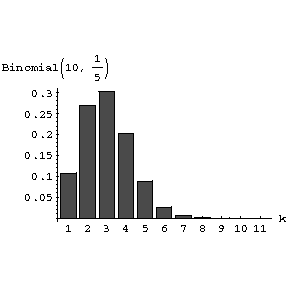Asymmetry coefficient
The most frequently employed measure of the asymmetry of a distribution, defined by the relationship
 |
where  and
and  are the second and third central moments of the distribution, respectively. For distributions that are symmetric with respect to the mathematical expectation,
are the second and third central moments of the distribution, respectively. For distributions that are symmetric with respect to the mathematical expectation,  ; depending on the sign of
; depending on the sign of  one speaks of positive asymmetry (
one speaks of positive asymmetry ( ) and negative asymmetry (
) and negative asymmetry ( ). In the case of the binomial distribution corresponding to
). In the case of the binomial distribution corresponding to  Bernoulli trials with probability of success
Bernoulli trials with probability of success  ,
,
 | (*) |
one has: If  , the distribution is symmetric; if
, the distribution is symmetric; if  or
or  , one obtains typical distribution diagrams with a positive (Fig.a) and negative (Fig.b) asymmetry.
, one obtains typical distribution diagrams with a positive (Fig.a) and negative (Fig.b) asymmetry.

Figure: a013590a
 . Diagram of the binomial distribution
. Diagram of the binomial distribution  corresponding to
corresponding to  Bernoulli trials, with positive asymmetry (
Bernoulli trials, with positive asymmetry ( ).
).

Figure: a013590b
 . Diagram of the binomial distribution
. Diagram of the binomial distribution  corresponding to
corresponding to  Bernoulli trials, with negative asymmetry (
Bernoulli trials, with negative asymmetry ( ).
).
The asymmetry coefficient (*) tends to zero as  , in accordance with the fact that a normalized binomial distribution converges to the standard normal distribution.
, in accordance with the fact that a normalized binomial distribution converges to the standard normal distribution.
The asymmetry coefficient and the excess coefficient are the most extensively used characteristics of the accuracy with which the distribution function  of the normalized sum
of the normalized sum
 |
where  are identically distributed and mutually independent with asymmetry coefficient
are identically distributed and mutually independent with asymmetry coefficient  , may be approximated by the normal distribution function
, may be approximated by the normal distribution function
 |
Under fairly general conditions the Edgeworth series yields
 |
where  is the derivative of order three.
is the derivative of order three.
References
| [1] | H. Cramér, "Mathematical methods of statistics" , Princeton Univ. Press (1946) |
| [2] | S.S. Wilks, "Mathematical statistics" , Wiley (1962) |
Comments
The asymmetry coefficient is usually called the coefficient of skewness. One correspondingly speaks of the skewness of a distribution and of positive, respectively negative, skewness.
The excess coefficient is more often called the coefficient of kurtosis.
Asymmetry coefficient. Encyclopedia of Mathematics. URL: http://encyclopediaofmath.org/index.php?title=Asymmetry_coefficient&oldid=45233